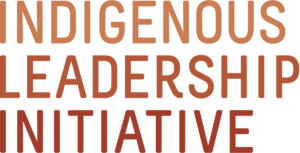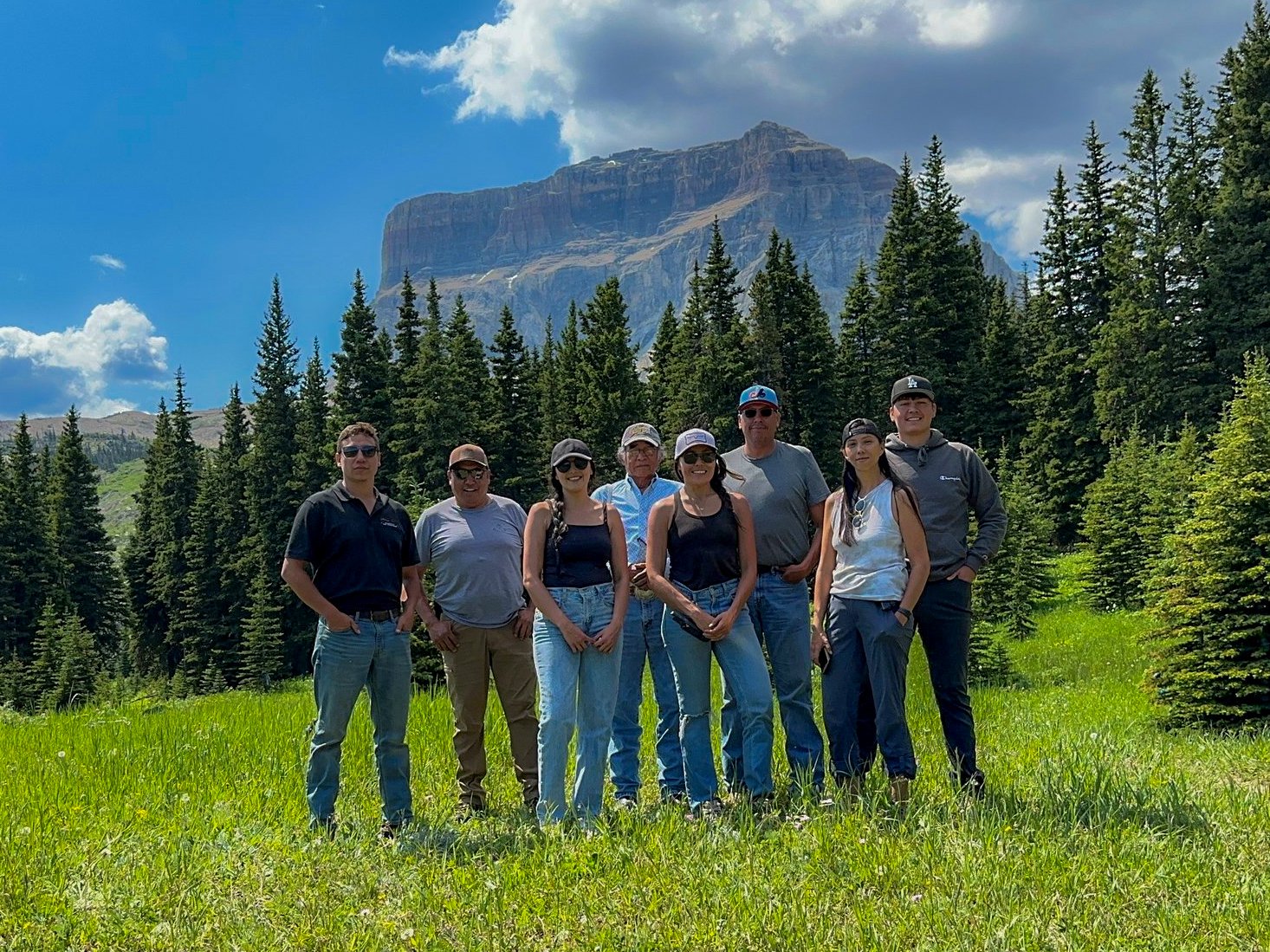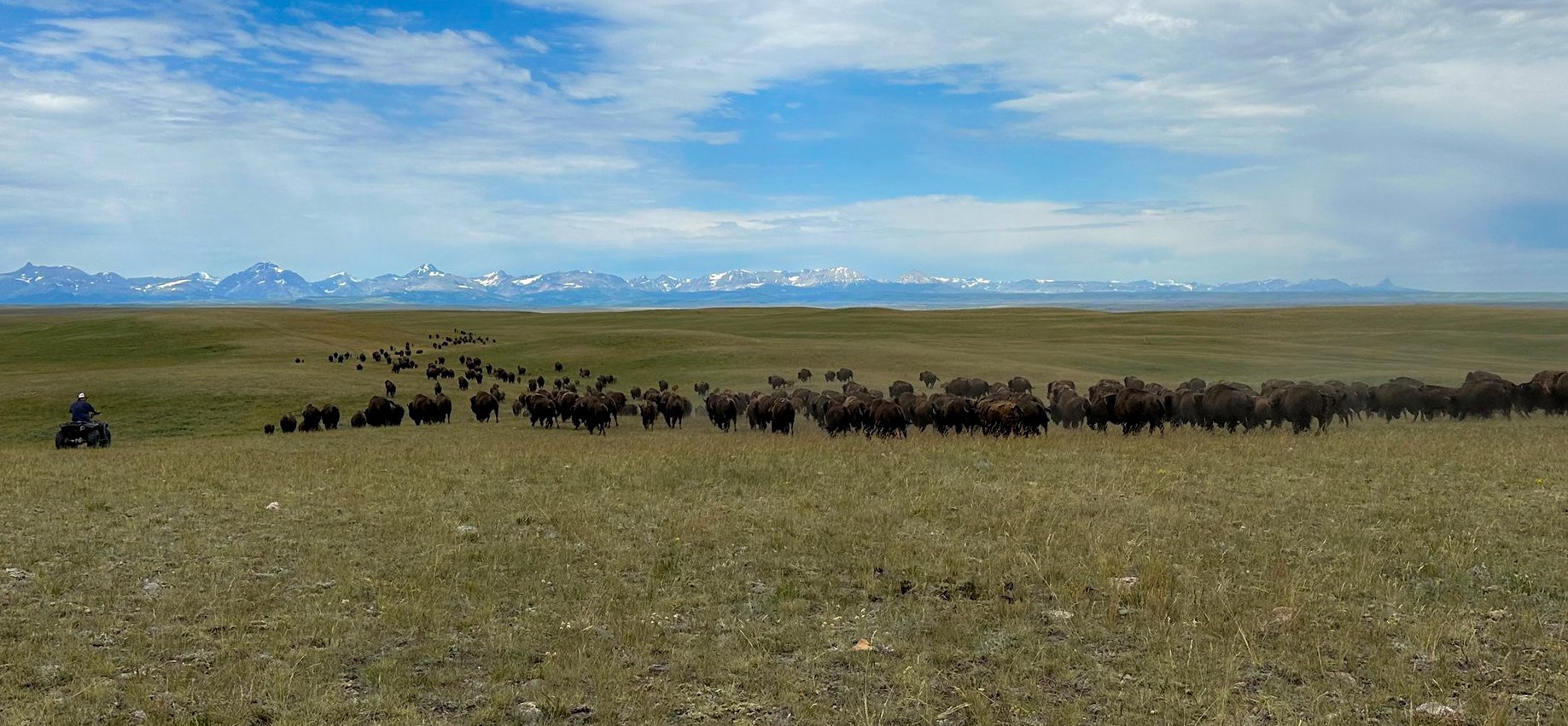“A Seat at the Table”: Blackfeet Shield Keepers Help Care for Land & Culture
Members of the Shield Keepers and representatives from Blackfeet Tribal Historic Preservation Office in front of Ninaistako. Credit: Darrell Hall
August 5, 2024
Ninaistako, known as Chief Mountain in English soars above the confluence where the northern plains meet the Rocky Mountains. The Blackfeet people have cared for Ninaistako for thousands of years. Today a group of tribal stewards known as the Shield Keepers helps fulfill that responsibility. In the warm summer months, the Shield Keepers can be found at Ninaistako conducting environmental studies about buffalo grazing with students from Blackfeet Community College, doing GPS mapping, and protecting ceremonial areas at the base of the mountain.
“This is what being a Shield Keeper is all about: Being on the land, in the community, with the buffalo,” said Darrell Hall. “We are working to bring our Blackfeet way of life back.”
The Shield Keepers are one of many tribally led stewardship programs emerging across what is now known as the United States. These initiatives—often called Guardians programs—help Tribal nations care for traditional territories by drawing on Indigenous knowledge, laws, and language alongside western science. They enable Nations to reestablish and exercise their inherent sovereign responsibilities to lands and waters.
“It’s so important for Guardians to have a seat at the table when agencies are building policies. Our Shield Keepers are talking with Elders, and they bring that knowledge into the policy work. It’s a huge resource for governments doing Tribal consultation.”
Emmette Dusty Bull joined the Guardians program this year. “As Shield Keepers, not only do we do the foot work, but we have a seat at the table. Whether it’s buffalo restoration or language and culture revitalization or government to government work, we have a voice.”
Buffalo, Restoration, and Healing
The buffalo are at the heart of much of this work. Blackfeet traditional territory stretches west from the Continental Divide, east across the plains of Montana, and north into Alberta. The iinnii (buffalo) used to roam these lands in the millions, and the Blackfeet’s relationship with the iinnii has nourished families, culture, language, and ceremony for millennia.
Yet after waves of settler colonialism, only about 300 iinnii remained in the wild by the late 1800s. Despite the devastation colonialism brought, the Blackfeet have never stopped fighting to honor the iinnii and maintain their cultural connection to both the land and the animals.
In 2023, the Shield Keepers helped when the Blackfeet became the first Indigenous Nation to repatriate free-roaming buffalo back to their original habitat. Credit: Darrell Hall
The Blackfeet Nation worked for years to bring iinnii home, and in 2023, they had a breakthrough when they released 25 wild buffalo from the Elk Island National Park in Canada—a herd that descends from the last remaining buffalo in Blackfeet territory. This made the Blackfeet the first Indigenous Nation to repatriate free-roaming buffalo back to their original habitat. The Shield Keepers helped with the release.
Returning wild buffalo through Blackfeet leadership has been an expression of sovereignty. And the ongoing stewardship of the buffalo continues to revitalize Blackfeet culture, communities, and the land.
“A lot of our Elders relate to the buffalo, because the Blackfeet were rounded up and put on reservations, and the buffalo were put in pastures,” said Shield Keeper Darrell Hall. “They tried to get rid of the buffalo, and they tried to get rid of the Indian. Now our cultural ways are making a comeback and so are the buffalo.”
“Everything is coming full circle,” Hall said. “We are in a time when we can be proud to be Blackfeet.”
Protecting Land and Culture
When the wild buffalo were released last year, they were brought to Ninaistako, and the Shield Keepers continue to monitor the area. Ninaistako is sacred to the Blackfeet, and the region has been closed to non-tribal members for many years, but a recent spike in tourism has drawn outsiders who left trash, taken selfies on top of fasting sites, and posted about trail access on social media.
“We have Shield Keepers out there now,” said John Murray, a Tribal Historic Preservation Officer and board member of Blackfeet ECO Knowledge. The Shield Keepers are “putting together policies and working with Glacier National Park on how to build signage and plan teachings.”
“One of the biggest things about being a Shield Keeper is going into the schools and talking about Blackfeet knowledge. I tell students we used to be called Lord of the Plains, and their eyes light up.”
The Shield Keepers work closely with the Blackfeet Tribal Historic Preservation Office, and this summer they assisted in repatriating a large collection of war shirts, regalia, bundles, standup head pieces, shields, and other ceremonial items.
“These items were so old, and they carried overwhelming energy in them. But we got them home,” said Shield Keeper Hall. “They will help show our people that we have our own way of life and our own creation story. I call it the Blackfeet knowledge school, where we learn what we should already know.”
“It’s good to get our knowledge of our way of life back to our people. Blackfeet headdress transfer is taking place. We are making a good trail for our youth to follow.” Shield Keepers help support cultural revitalization. Credit: Darrell Hall
Working with Government Partners
Caring for Blackfeet culture and traditional territory means the Shield Keepers collaborate with a range of partners. The Blackfeet reservation sits alongside lands claimed by the National Park Service and the Forest Service, and both agencies have a history of removing Indigenous people and disregarding treaty rights. Today, the Blackfeet Nation is forging relationships with its neighbors that respect sovereignty.
The Blackfeet, for instance, hold reserved treaty rights in Glacier National Park and are drafting co-management agreements with the park. Waterton National Park, just north of the Canadian border, is also working with the Blackfeet, including on the possibility of the Nation’s wild buffalo migrating in and out of the park.
“It’s so important for Guardians to have a seat at the table when agencies are building policies,” said Lona Running Wolf, the executive director of projects for Blackfeet ECO Knowledge. “Our Shield Keepers are talking with Elders, and they bring that knowledge into the policy work. When policies are not developed in our world view, they maneuver around barriers to make change. That’s what they do when they have a seat at the table. It’s a huge resource for governments doing Tribal consultation.”
Federal agencies increasingly recognize the value of this knowledge. The National Fish and Wildlife Service asked to partner with the Blackfeet on an upcoming cultural training workshop that will convene Elders and representatives from several nations. Shield Keepers are helping plan and host the training so federal staffers can learn more about how to work with Tribal nations.
“I’m glad we can present to Fish and Wildlife,” said Emmette Dusty Bull. “They will get an independent understanding of who we are as Piikani people.”
In addition to conducting environmental monitoring around Ninaistako, Shield Keepers also protect ceremonial sites around the mountain. Credit: Darrell Hall
Building Momentum
The summer training is just one of many projects Shield Keepers are planning, ranging from more buffalo releases to new environmental studies. They also hope to collaborate with other Tribal Nations building stewardship programs, some of which are inspired by similar work among First Nations in Canada. “The dream of bringing more Guardians to the U.S. is something we are excited to be part of,” said Lona Running Wolf.
Meanwhile, the Shield Keepers continue helping sustain Blackfeet land and culture for the future. “One of the biggest things about being a Shield Keeper is going into the schools and talking about Blackfeet knowledge.” Said Darrell Hall. “I tell students we used to be called Lord of the Plains, and their eyes light up, and they feel so proud when they hear that. It’s good to get our knowledge back to our people. We are making a good trail for our youth to follow.”
“They tried to get rid of the buffalo, and they tried to get rid of the Indian. Now our cultural ways are making a comeback and so are the buffalo.” Credit: Darrell Hall






